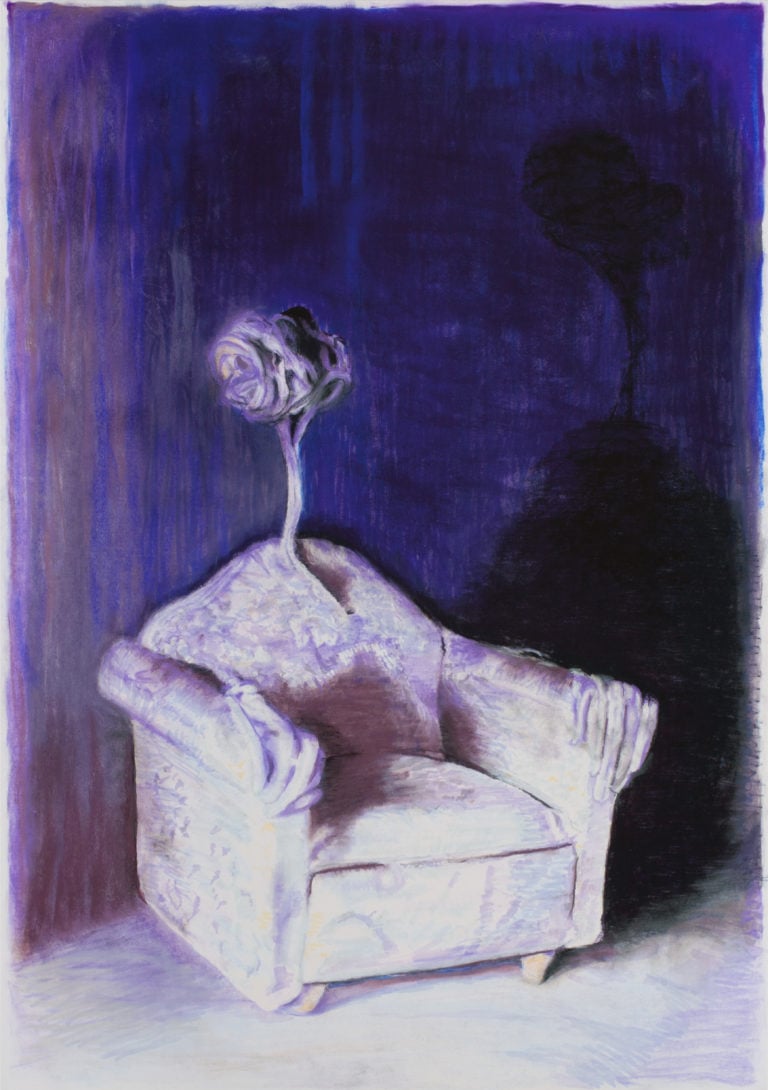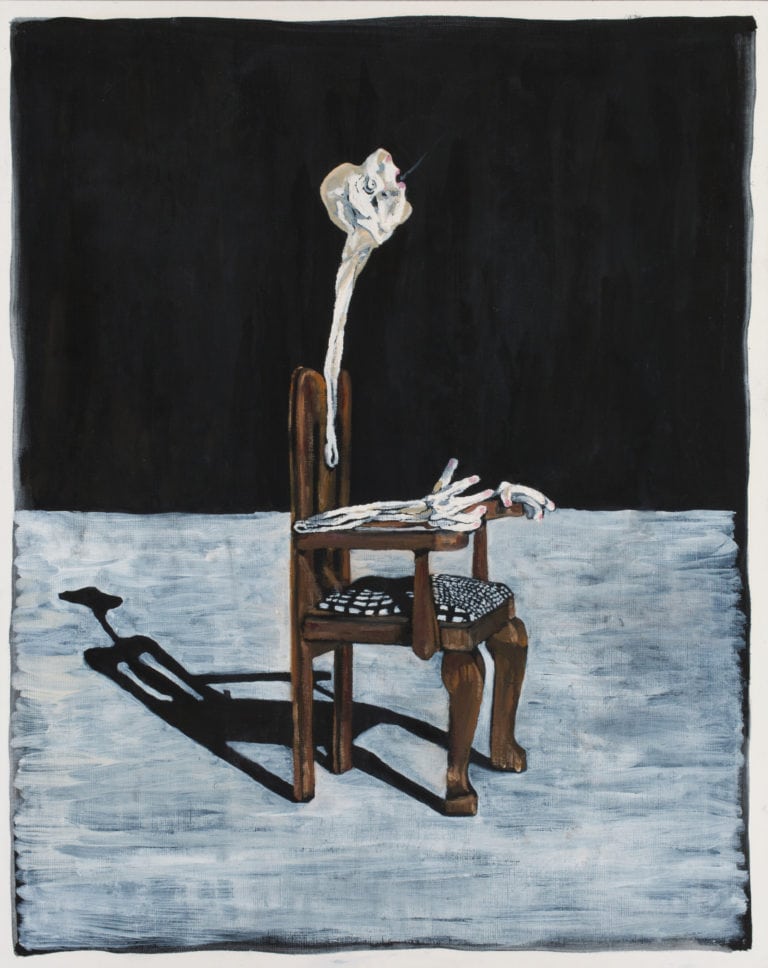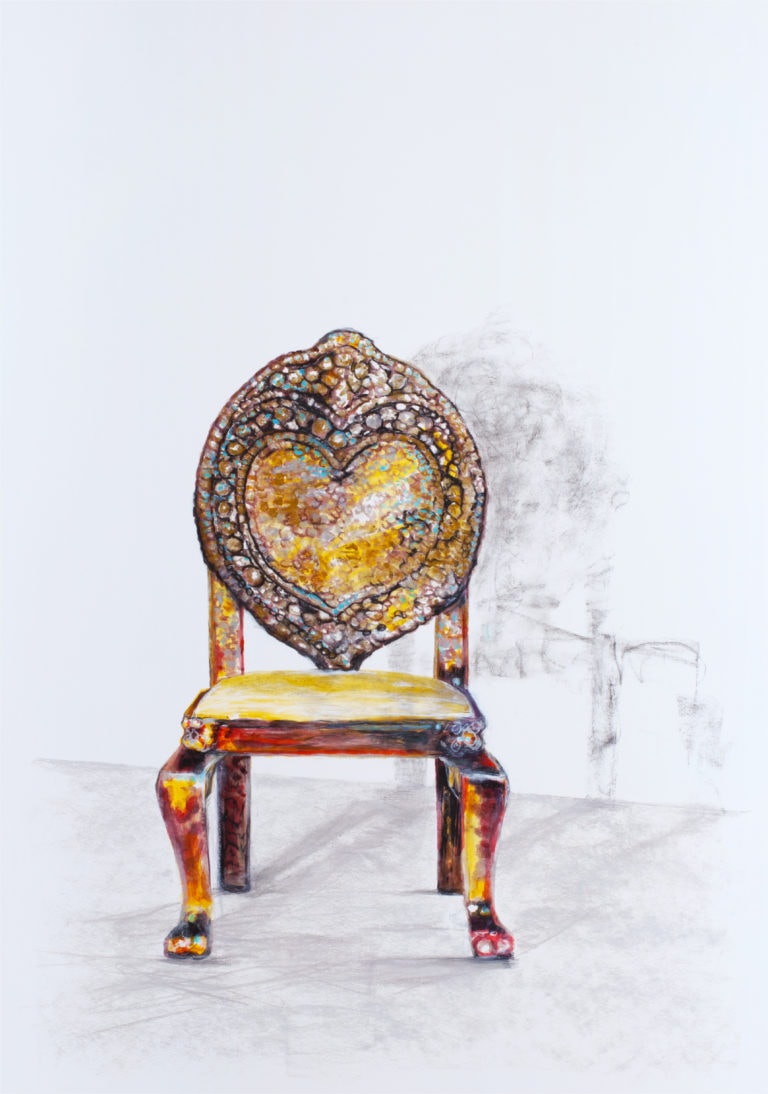Clare
Shenstone
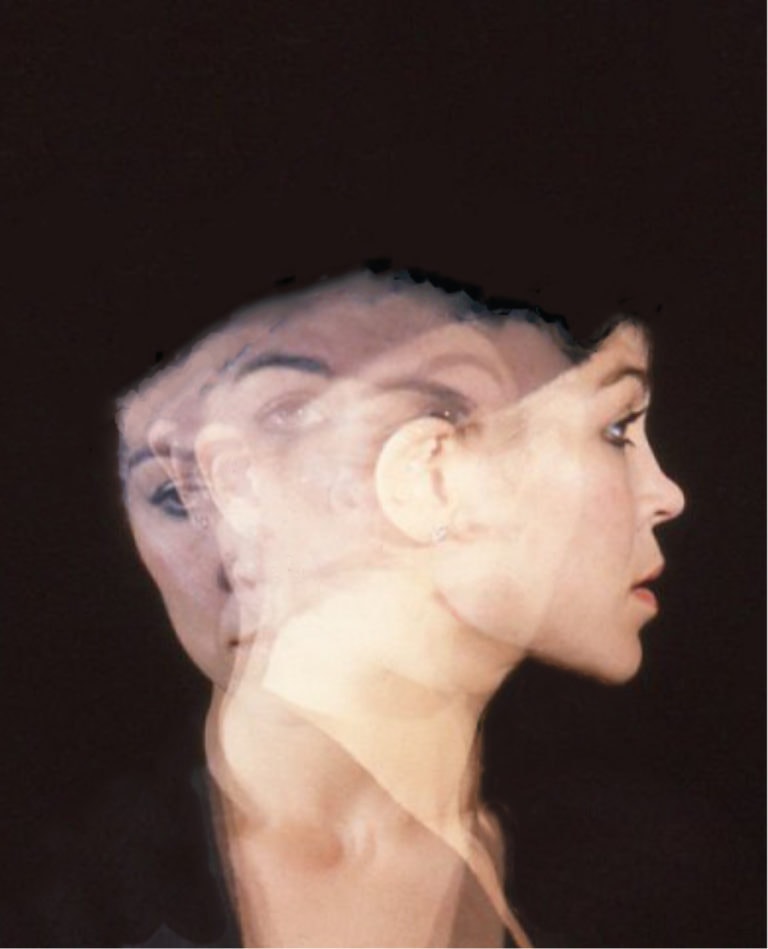
“Don’t go down the black hole, don’t make it about yourself; make it about the outside world. Just jump off…”
Clare Shenstone launched August 18
The jaw-dropping anecdotes that span Clare Shenstone’s life can be distracting. She’s the only artist Francis Bacon commissioned to create his portrait; there’s her life-long connection with David Bowie, and the iconic poster for Warhol’s Chelsea Girls. But the fascination she attracted from the most astounding creative minds is not the story of why Clare Shenstone is an incredible artist…
It might be surprising that I’m focusing on the works that Shenstone calls the ‘chair people’, after all here’s an artist who is renowned for her portraits of the countless celebrated people who were part of her close circle… Bowie, Bacon, Iman. The chair people have recurred throughout Shenstone’s career, and while the relationship between sitter and chair has been one of her ever-pressing fascinations, these people appear to land from a different realm altogether. In reality, however, that’s not strictly the case; drama, humour, the macabre, pain and all sorts of fleshy humanness are embodied in even the most ‘classical’ of Shenstone’s portraits.
“There’s a sense of the stage, of drama in all my works. When you draw or paint someone they become the lead part as it were.”
Look at her paintings and you’ll see that Shenstone handles the human form with such meaty intimacy that the surfaces are often tangibly sculptural. She always has a way of showing us that she was there in the moments she created her art, up-close with her subjects, physically grafting, extricating and implicating the unseen spaces their presence ignites. And what consistently marks the power of Shenstone’s art is that her portraits are never boastful statements, instead they feel like they nudge us into new spaces of our own world. The chair people, with all their strangeness, are skinned of identity but bursting with personality. They’re abundantly human, excessively human, and we’re all in there somewhere.
Chair and person intertwined as a single sinuous being, and for an artist who is consumed by all the unseen inputs that create us, that makes total sense: in reality, aren’t chairs and bones wrought for the same simple purpose, to prop us up? And whatever realm these chairs take us into, their serial reappearance is a touching homage to Shenstone’s lineage in portraiture. So often serving a quiet but dependable supporting role to the real meat of the subject – the human being who sits in it – these chairs somehow charmingly remind us that they’ve been here all along.
“Everyone who has sat in the chair has left some kind of memory. The chair simply lives through time and accommodates people. And that ingratiates it to me.”
And therein lies some of the character and tension of these scenes, that the immediate reality of these beings – a mix of human and chair legs and arms – appears to be an absurd predicament, a jostle both for and against their co-dependency and own identity. In some of the works the figures are spot-lit, casting their own dramatic shadows on stage-like platforms, which dials up the sense of drama into allegory, and these chair people feel like caricatures performing in some painterly theatre that’s based on their own true stories.
They’re genial and ponderous figures; always preoccupied. Some are elongated and seductive, others are craning, tangled riddles. They all seem caught in a palpable annex that straddles the real and non-physical world; captured between a static, everyday reality and restless disembodied distraction. Shenstone once showed me candid photographs of Francis Bacon that she deliberately took right at the moment she asked him a question. There’s something of that approach here – that moment the body concedes its external form to all of its thoughts.
So for all the visceral contortions that at their most extreme could push these scenes into some tortured psychosis, they never become that. They feel meticulously real. Some of them – an armchair in a household room – even feel mundanely familiar.
Shenstone habitually draws from moving life, often in series, depicting the same figure from multiple angles or in different postures, as if she’s tracing her own witness to passing moments. She never really claims to own those moments but in doing so allows them to be all the more vivid. These graphic hallucinations feel legitimately part of our complex reality: the physical is only a sliver of our existence, planted as we are in this world, resolutely curious, propped up by chair legs.
The path to where I would go. Shenstone retraces her steps…
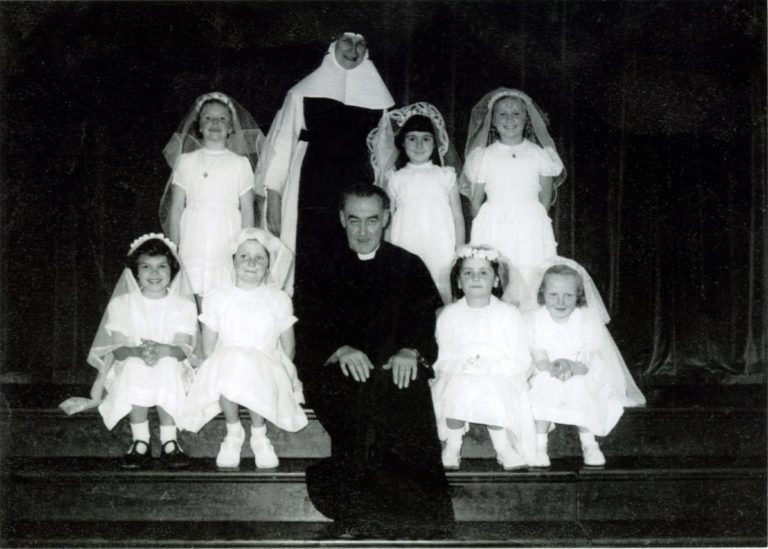
Clare [first row, first left] photographed to mark the First Holy Communion.
I had never considered art as a way of earning money. It was part of me and I called it my personal research. When I grew out of wanting to be a mermaid, I wanted to be an actress. I played Puck in A Midsummer Night’s Dream when I was 6 years old.
One early memory from school was my First Holy Communion. We were given a special breakfast afterwards and I remember my best friend Miren, on being offered a bowl of cornflakes, replying, “I couldn’t possibly. I’m too full up with Jesus.” My disillusionment set in aged about 10 or 11.
Moving to London from Essex I continued my art but was pursuing acting as my career, working mostly in live theatre but also in TV and film. By the time I was touring Europe with The Prospect Theatre Company, I was spending all day in the most wonderful museums… I was completely obsessive about what I was looking at.
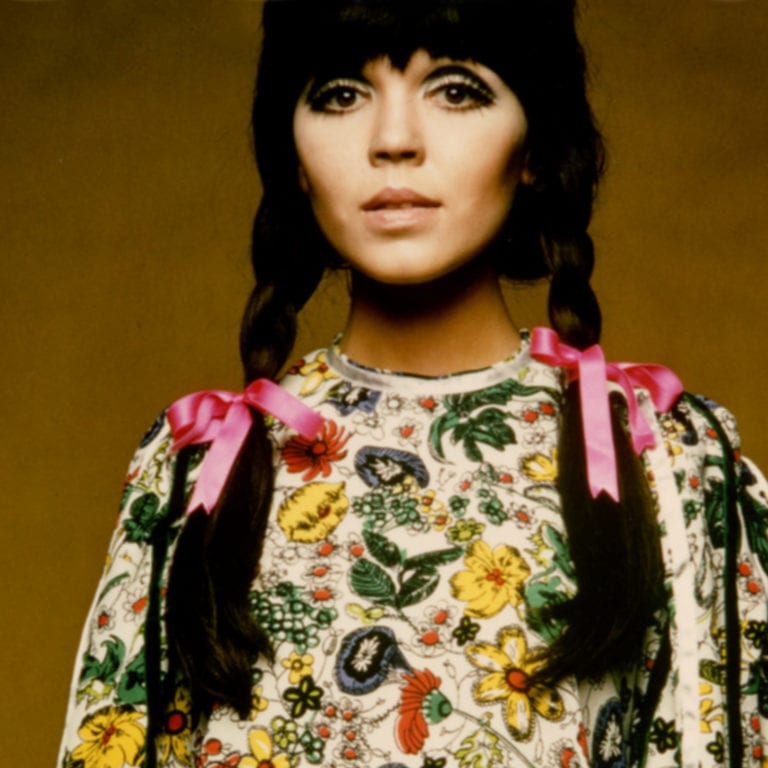
Clare, photographed in the ’60s
It’s no small achievement to reach a position where you’re sure you know what you’re pursuing, moreover to create a situation in which you can function within that choice. I was acting to pay my rent; creatively the theatre relies on many people coming together and working selflessly, and that’s seldom the case.
In ’76 I was still performing Ivanov at the Aldwych at night when I started at the RCA. One day, just as I was leaving my studio for the theatre, David [Bowie] rang me. He said he needed me to come to Berlin and be with him, he told me it was really urgent. I told him to ring back after the performance.
I rushed off and Zoë [Wanamaker], who I shared the dressing room with, could see I was worried. “Okay, what’s going on?, she demanded. I told her about David. “I can’t just disappear to Berlin, I have the RCA and the RSC.” Zoe pointed out that we did not have another performance until the following week. So I told David I could come. He met me at the airport.
Berlin became symbolic of our dream of being married, but as the line in Heroes surmised… “nothing will keep us together.” I never understood it at that point and we were both close to having breakdowns by the time what we both knew became undeniable… he could not give up making and performing music and I could not produce art if I was following David around.
I stayed with my painting and he with his music. We did not make a choice, either of us, we just had to be ourselves, forever. And that will always be my path.
Reading
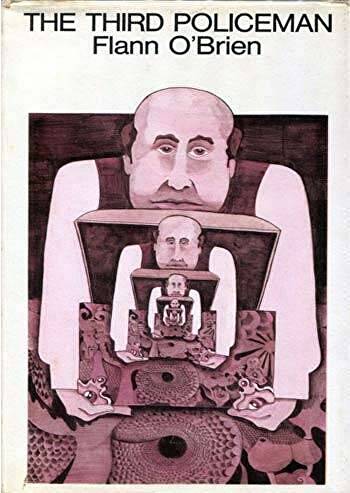
Flann O’Brien’s ‘The Third Policeman’ is an extraordinary mixture of invention, beautiful ideas, menace and comedy. His writing is genius. The three ideas so close to my heart are mentioned below. I wish it was possible to quote each extract in full but I hope you may read them yourself.
“What’s your colour? Surely you know you have a colour?”
Here begins a passage about what colour you are, which is determined by the combination of the colours of the winds blowing at the time of your birth. A very thin garment is made of that colour, which you wear against your skin, and each birthday you are gifted a new one to be worn over the previous garments. Gradually the layers create a darker colour until it eventually becomes black, when you die. The concept of this precious, transparent little gown becomes symbolically combined with the idea of protection and beauty and identity but also with restriction and ultimately the foreboding of death.
“He went to the little chest and opened it up again and put his hands down sideways like flat plates or like the fins of a fish and took out of it a smaller chest but one resembling its mother-chest in every particular appearance.”
The policeman makes breathtakingly beautiful little chests, which he’s been making for many years. They’re identical, but for the fact that each subsequent chest is slightly smaller so it can be placed inside the previous one. His work has gone on for so long that not only are the chests now so small that they cannot be seen by the naked eye, but so too are the tools he uses to make them. It is the most exquisite idea and the most beautiful illustration of the gradual realisation that the viewer is experiencing his first encounter with the mystery of the creative power of a human being to produce a work of art beyond understanding yet tangible.
“How can I convey the perfection of my comfort on the bicycle, the completeness of my union with her…?”
This passage is a description of a bicycle that is an individual and unique presence and one of its kind. It describes the development of the viewer gradually believing he has become one with the bicycle. I share with O’Brien this attitude towards objects that have a life of their own. Bicycles, like chairs, were invented to facilitate human beings; objects in their own way become alive, like us, and that is very fundamental to my art and the way I work.
Listening
Music is my idea of heaven. I think that music is the most magical and beautiful and life-enforcing power there is. Music has helped me through all sorts of difficulties and trials in the most profound ways, so when I was asked to make a short selection of the most powerful music in my life, I couldn’t. It’s an impossible and futile task. Instead, I’ve chosen three albums, and a song from each, that I have always loved out of thousands. All the works of Monteverdi and J.S. Bach to Jimi Hendrix and Amy Winehouse would be on my list.
‘Exodus,’ Bob Marley and the Wailers (1977)
‘The Rolling Stones,’ The Rolling Stones (1964)
‘Sgt. Pepper’s Lonely Hearts Club Band,’ The Beatles (1967)
Timeline
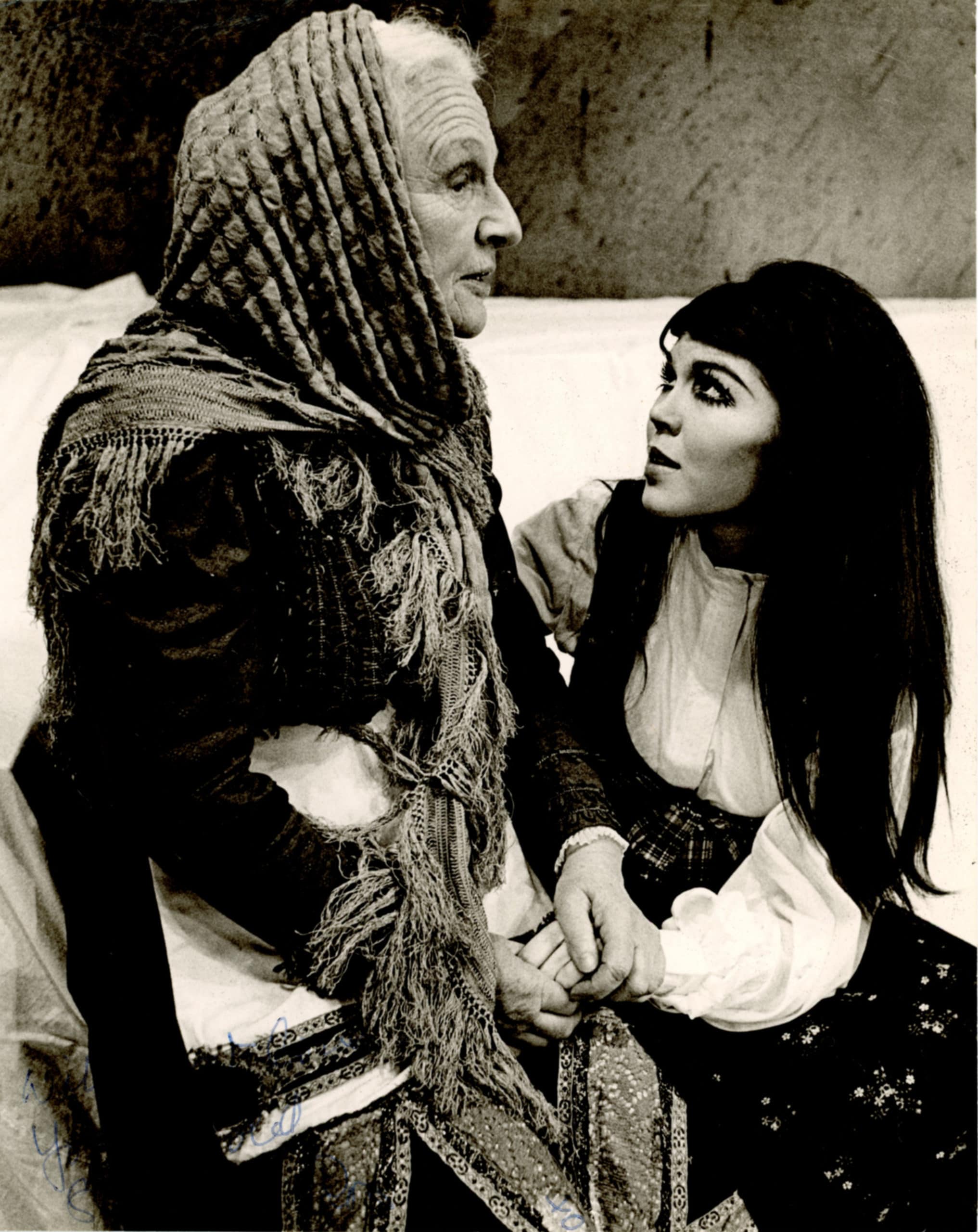
Shenstone performing in Peer Gynt
1969-70:
ACTING
Henrik Ibsen’s Peer Gynt.
Shenstone was cast as Solveig in the Oxford Playhouse Company’s production of Peer Gynt in Oxford, which then toured the UK.
1966:
Chelsea Girls poster released.
Shenstone modelled for what would become one of the most iconic film posters of all time: the Alan Aldridge-designed poster for the release of Andy Warhol’s film Chelsea Girls. Warhol famously commented that he “wished the movie was as good as the poster.”
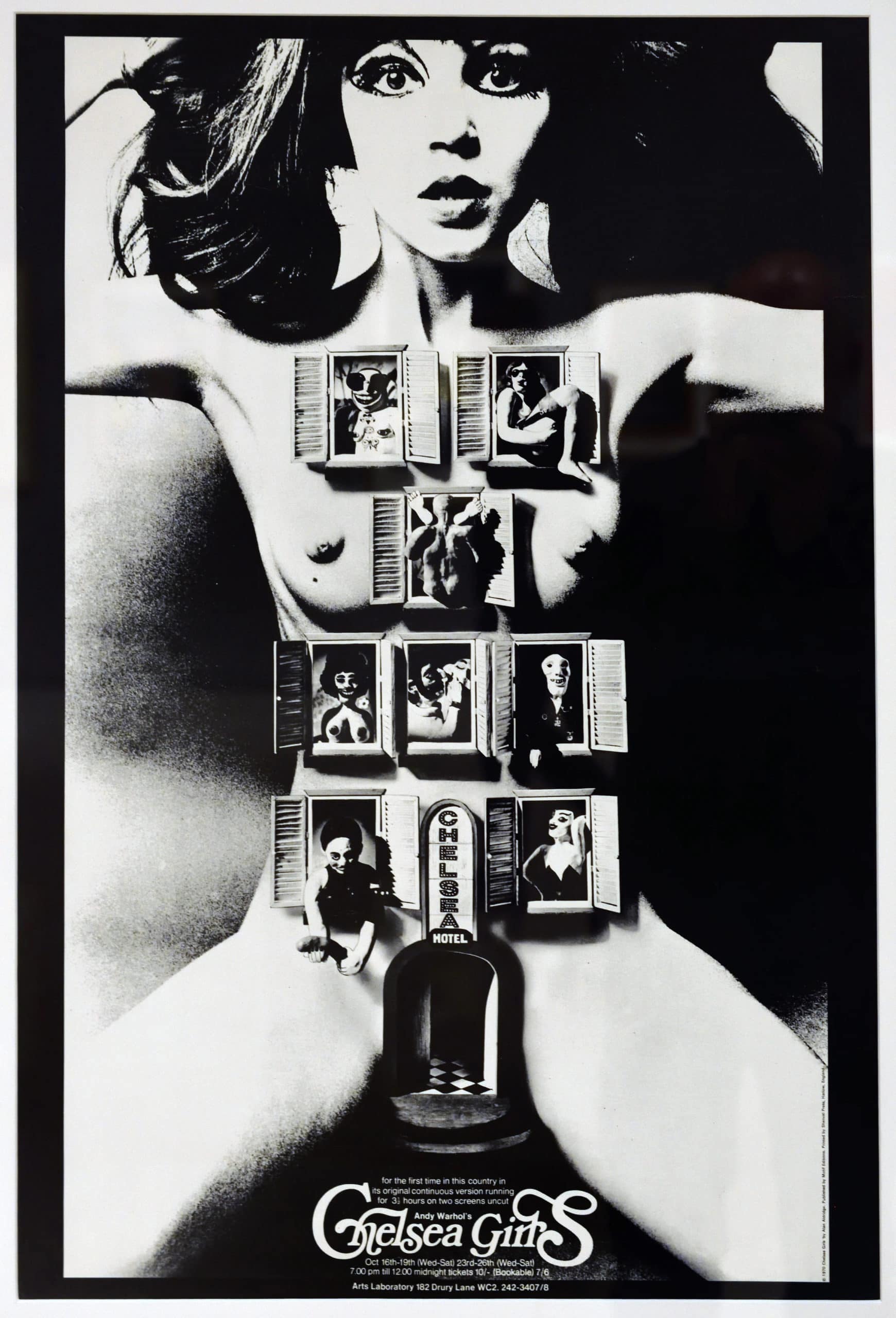
Poster for Warhol’s ‘Chelsea Girls’
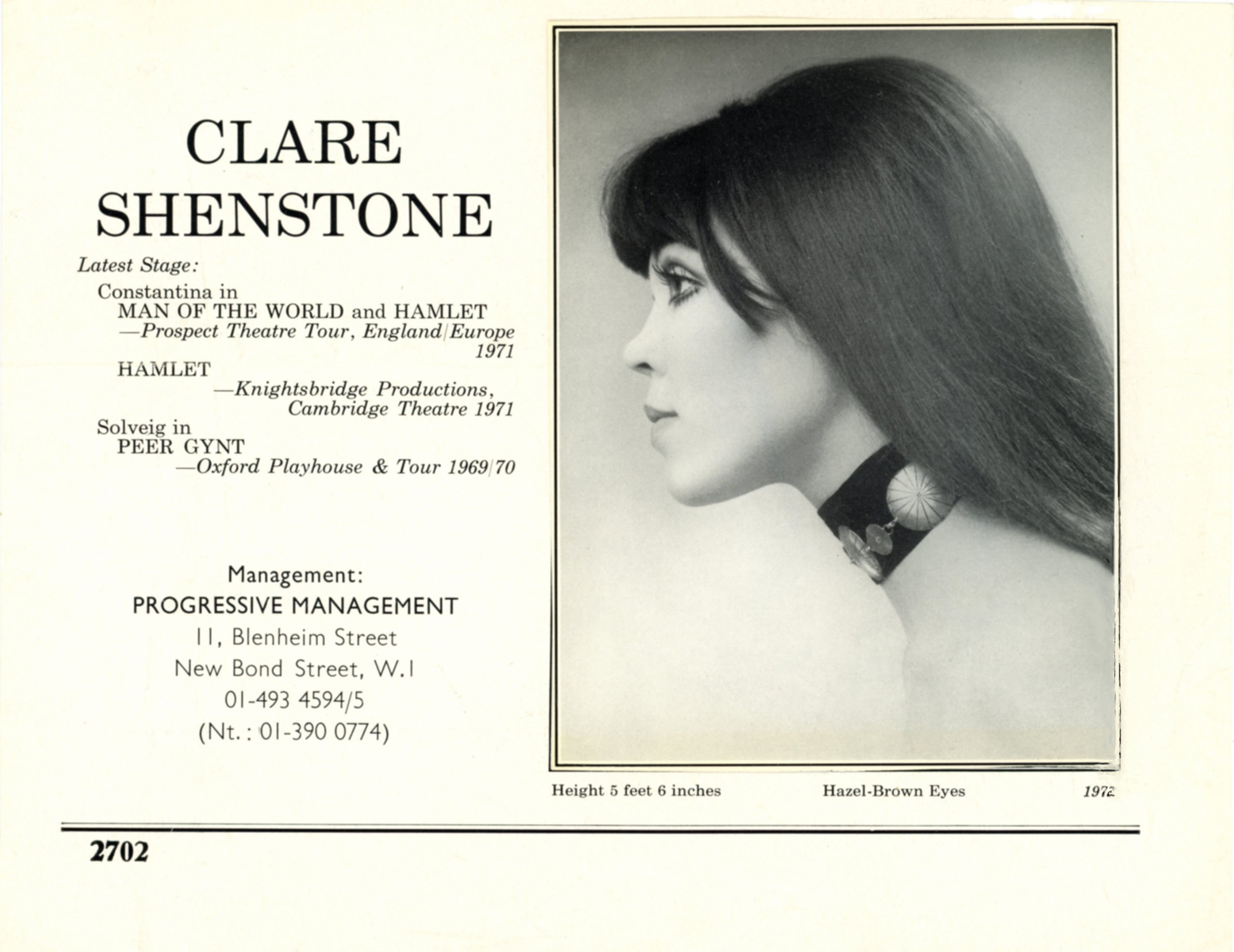
1970-71:
ACTING
Joins Prospect Theatre Company.
Shenstone joins the Prospect Theatre Company playing Constantia in Man of the World and then performing in Sir Ian McKellan’s Hamlet, touring the UK and then Europe.
1971-72:
ACTING
Shakespeare’s Hamlet.
Shenstone took on the West End run of Sir Ian McKellen’s Hamlet at the Cambridge Theatre, London, working on her art in the daytimes and performing in the evenings.
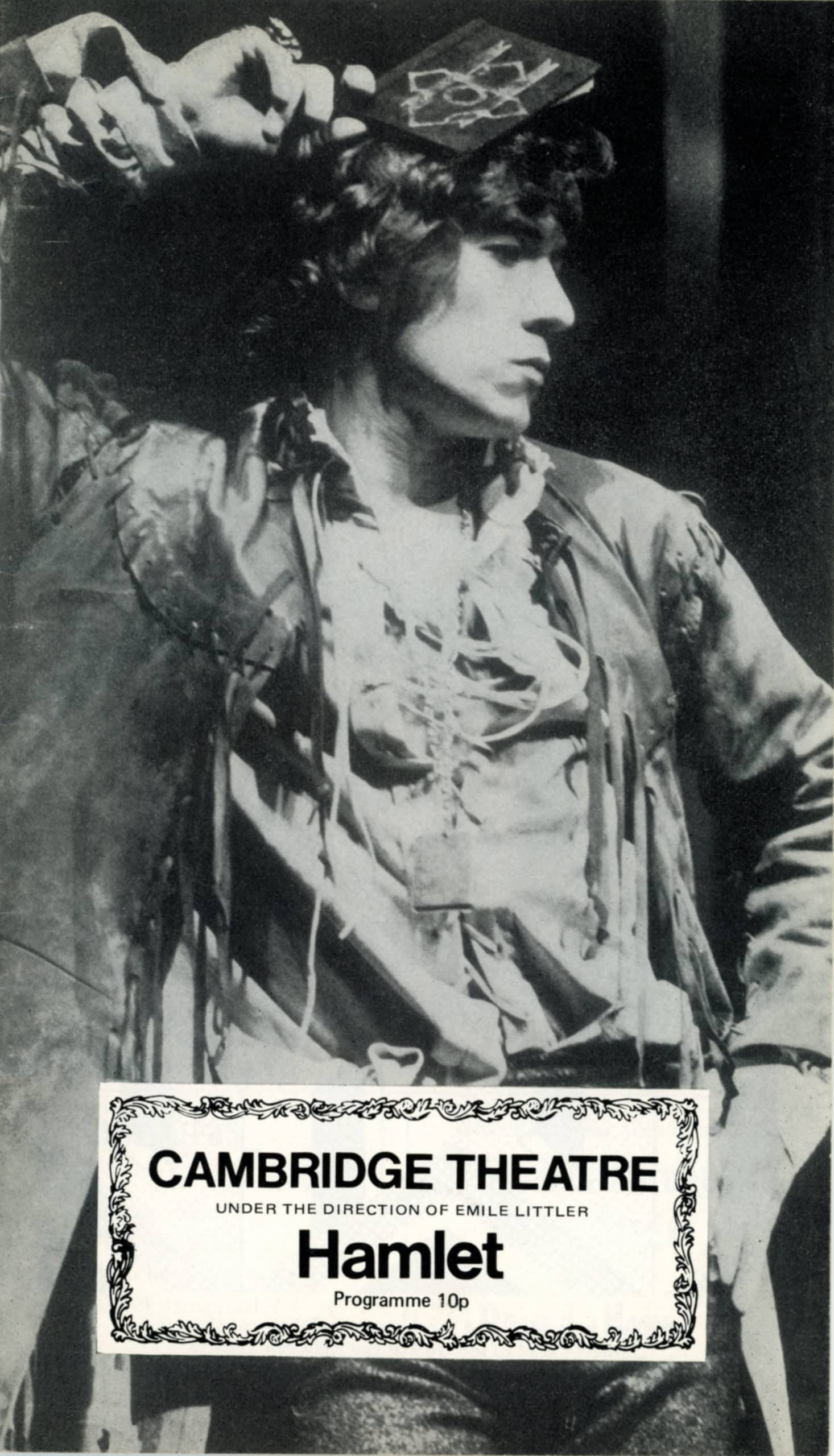

The Central School of Art and Design, London
1972-3:
STUDY
Foundation, Central School of Art and Design, London.
1973-6:
STUDY
BA Painting, Chelsea School of Art, London.
Shenstone’s early work was markedly different to the work she has become known for. During her BA degree she created big, abstract wall hangings based on studies of trees.

One of Shenstone’s early wall hangings
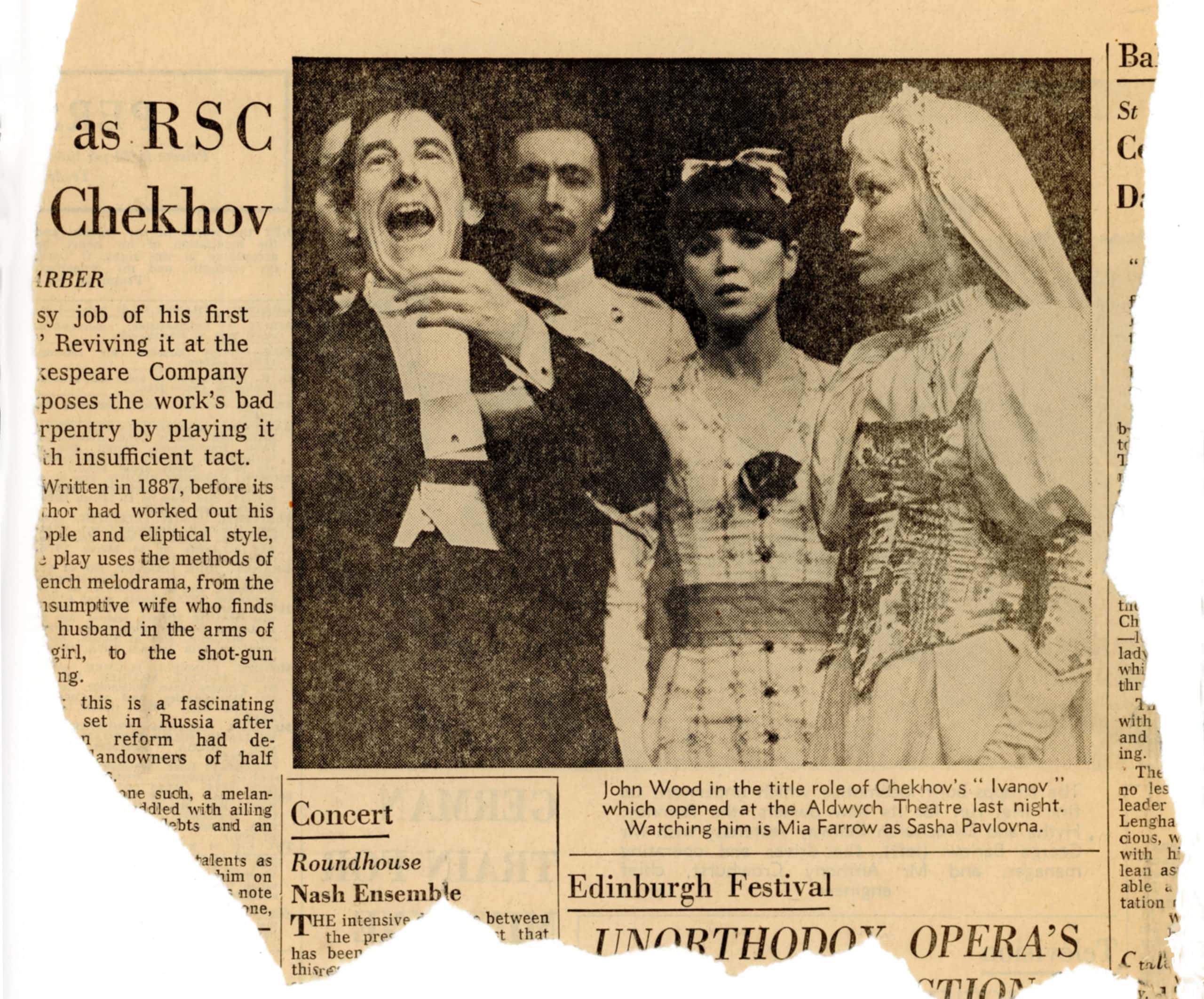
Shenstone performing in Ivanov alongside Mia Farrow
1976:
ACTING
Joins Royal Shakespeare Company.
Shenstone played alongside John Wood and Mia Farrow in the Royal Shakespeare Company’s production of Chekhov’s Ivanov at the Aldwych Theatre.
1976-79:
STUDY
MA Painting, Royal College of Art, London.
Shenstone returned to rigorously drawing from life during her RCA days; however most notably it was here that Shenstone developed her unique ‘cloth head’ technique.
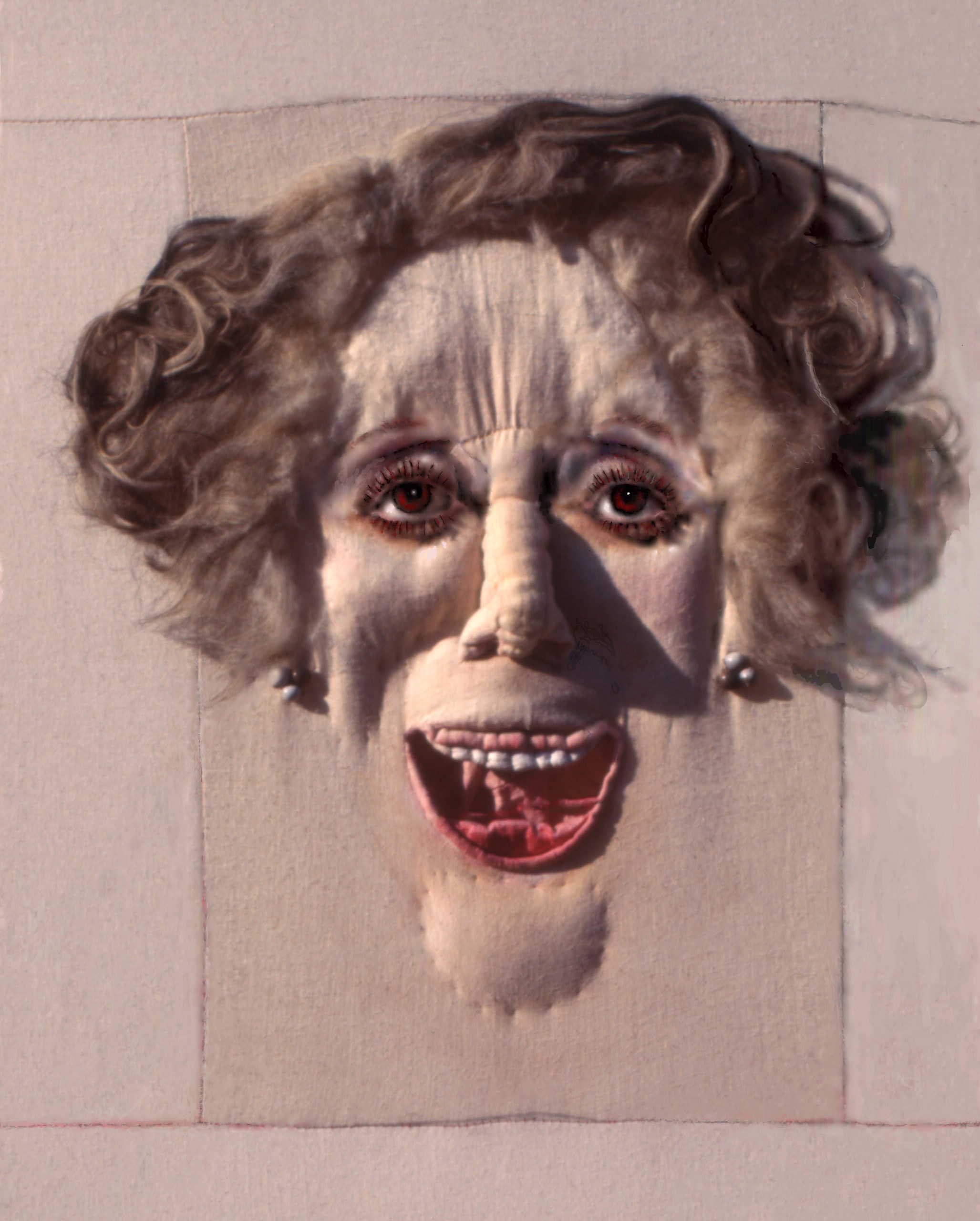
Shenstone’s first cloth head, ‘Janet’

‘Janet’ hanging in Francis Bacon’s studio
1979:
ACQUISITION
Francis Bacon buys Janet.
A visitor to Shenstone’s RCA graduation show left his telephone number. It was Francis Bacon: “I adore your work”, he told me. “My gosh!” I said, “well, I think you’re the best artist alive in the world today.” He said, “Great minds think alike! I love Janet. Will you let me buy her?” I told him there’s nobody I would rather have a piece of my work.
1980:
EXHIBITION
Lyric Theatre Hammersmith, London.
A solo exhibition to launch the opening of the new Lyric Theatre in Hammersmith, which featured Bacon’s loan of Janet.
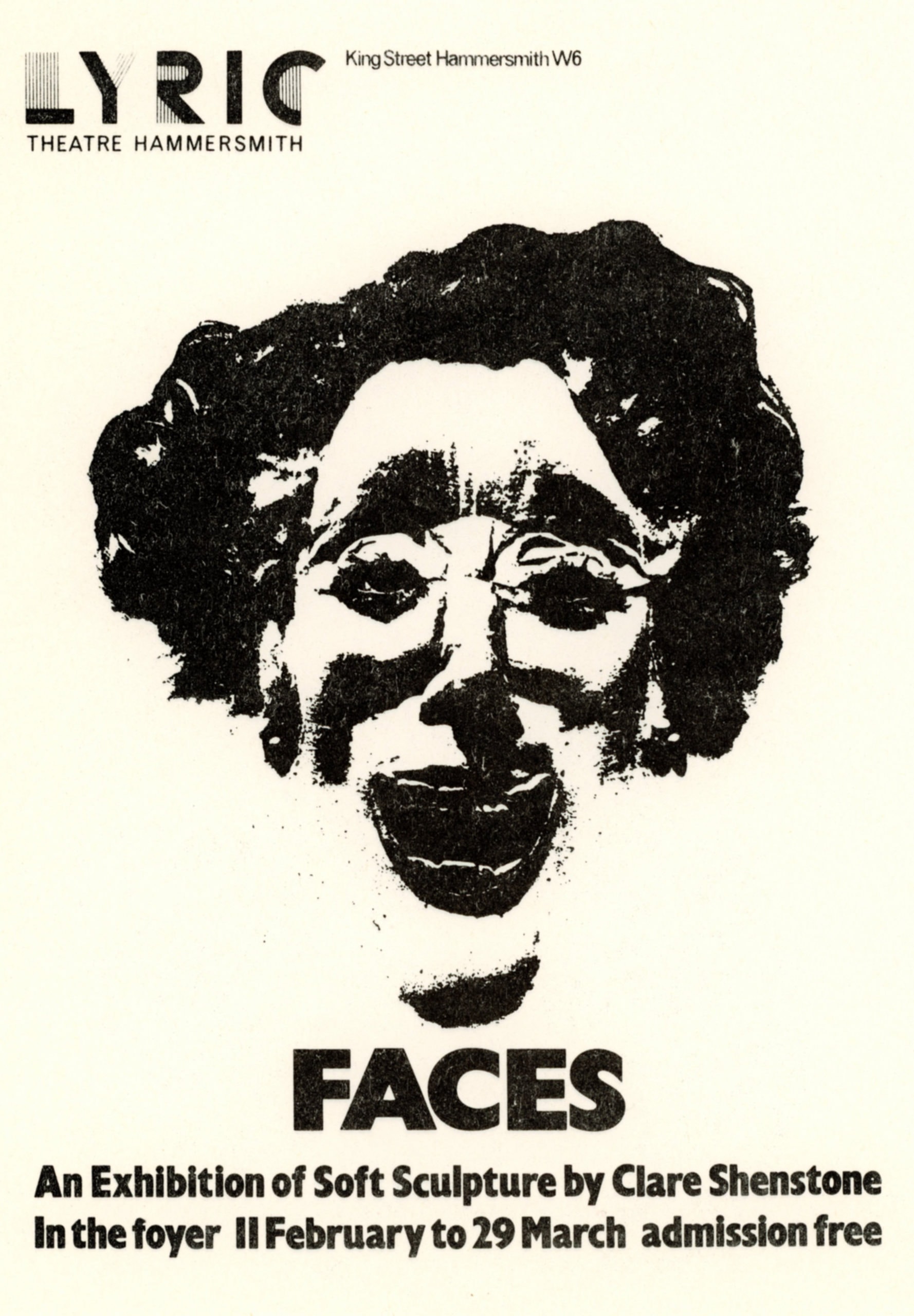

One of many photographs of Francis Bacon by Shenstone
1980:
COMMISSION
Francis Bacon Portrait.
Following the return of Janet from the Lyric Theatre, Francis Bacon rang: “I’ve been thinking, would you do my portrait? A cloth head.” “Oh God!” I replied, I don’t know whether I can.” I’d never made a formal portrait. “Will you try?” he asked, and I agreed to have go. “We’ll just see what happens,” he said, “you come around, we’ll chat about it and let’s have a sitting.”
1980:
COMMISSION
Paintings for ‘Escape!’
Commissioned by the BBC to create the paintings of the central character in Shane Connaughton’s screenplay.
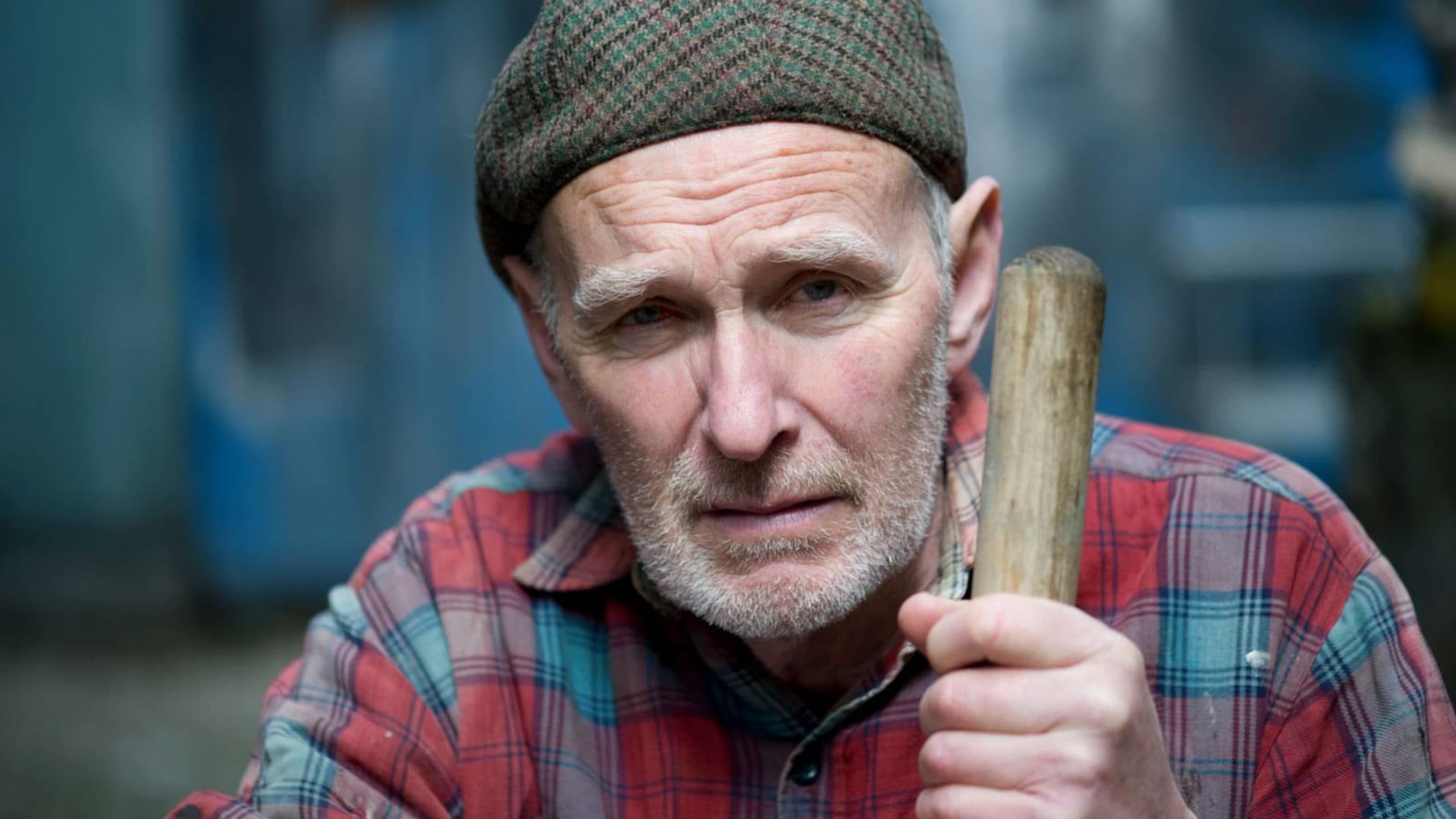
Shane Connaughton

1981:
COMMISSION
Manhattan Theatre Club, New York.
Manhattan Theatre Club produced their own production of ‘No End of Blame’ and commissioned further work from Shenstone.
1981:
COMMISSION
Drawings for ‘No End of Blame’.
The Oxford Playhouse Company commissioned Clare to create six drawings for one of the two main characters and Gerald Scarfe was commissioned to create six drawings for the other. The images were projected as the backdrop to each scene. The play transferred to the Royal Court Theatre, London.

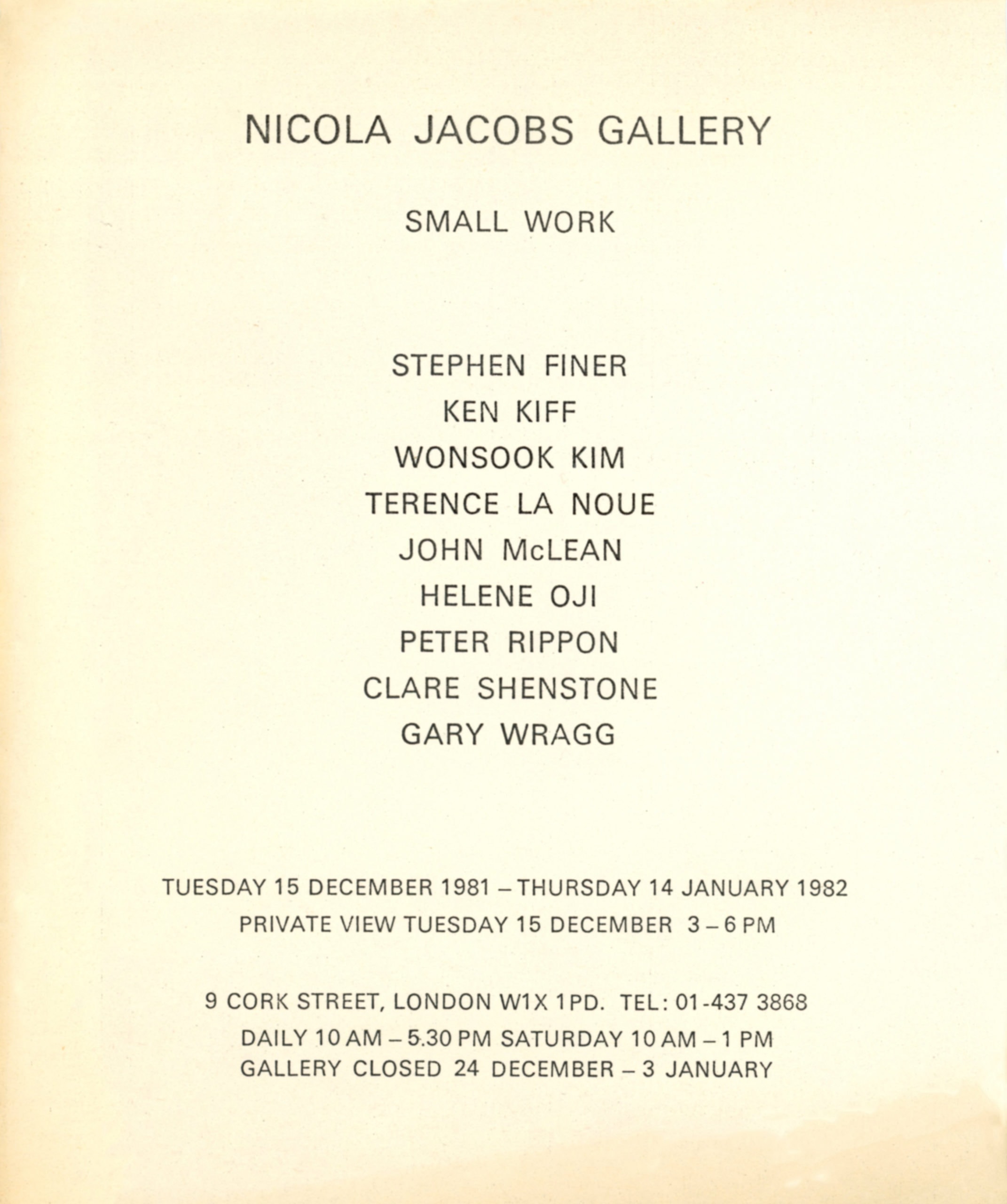
1982:
EXHIBITION
“Small Work”, Nicola Jacobs Gallery, Cork Street, London.
1982:
EXHIBITION
‘Artists of the Colony Room Club: a Tribute to Muriel Belcher’, Parkin Gallery, London.
Muriel Belcher was the inimitable founder of the Colony Room Club in London. Until Belcher’s death in 1979, the club hosted a who’s-who of cultural greats, including Lucien Freud, William Burroughs, Henri Cartier-Bresson. Shenstone exhibited in Parkin Gallery’s celebration of Belcher’s life.
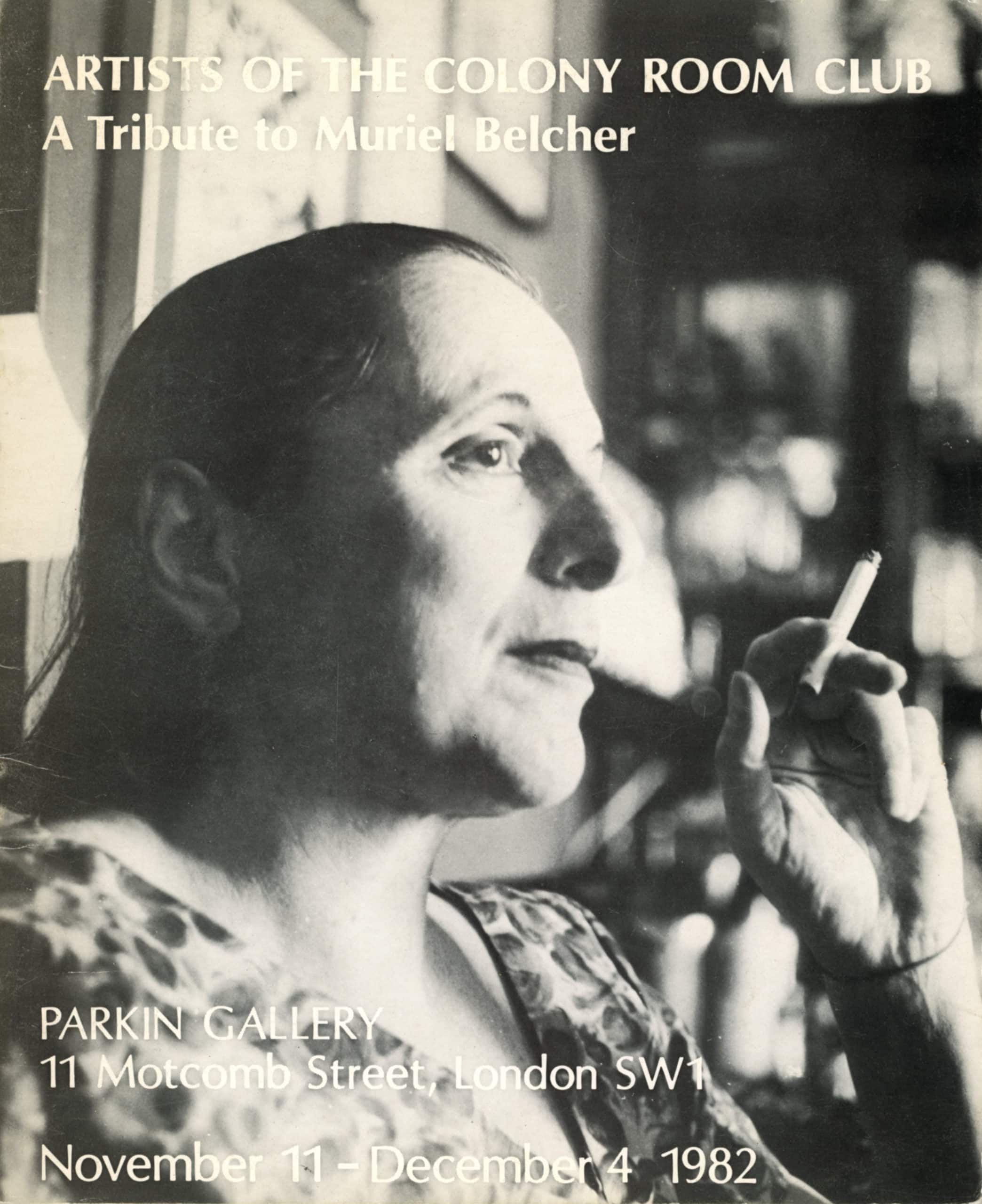

Whitechapel Gallery, London
1983 & 84:
EXHIBITION
Whitechapel Open Exhibition, Whitechapel Gallery, London.
Shenstone’s work was exhibited in consecutive years in the Whitechapel Gallery’s ‘Whitechapel Open Exhibition.’
1984:
COMMISSION
Clare completes portrait of Francis Bacon.
At the Marlborough Gallery in London, Shenstone unveils the cloth head portrait that Francis Bacon commissioned; “I can get rid of my mirror now,” he says, “I won’t be needing it anymore.”
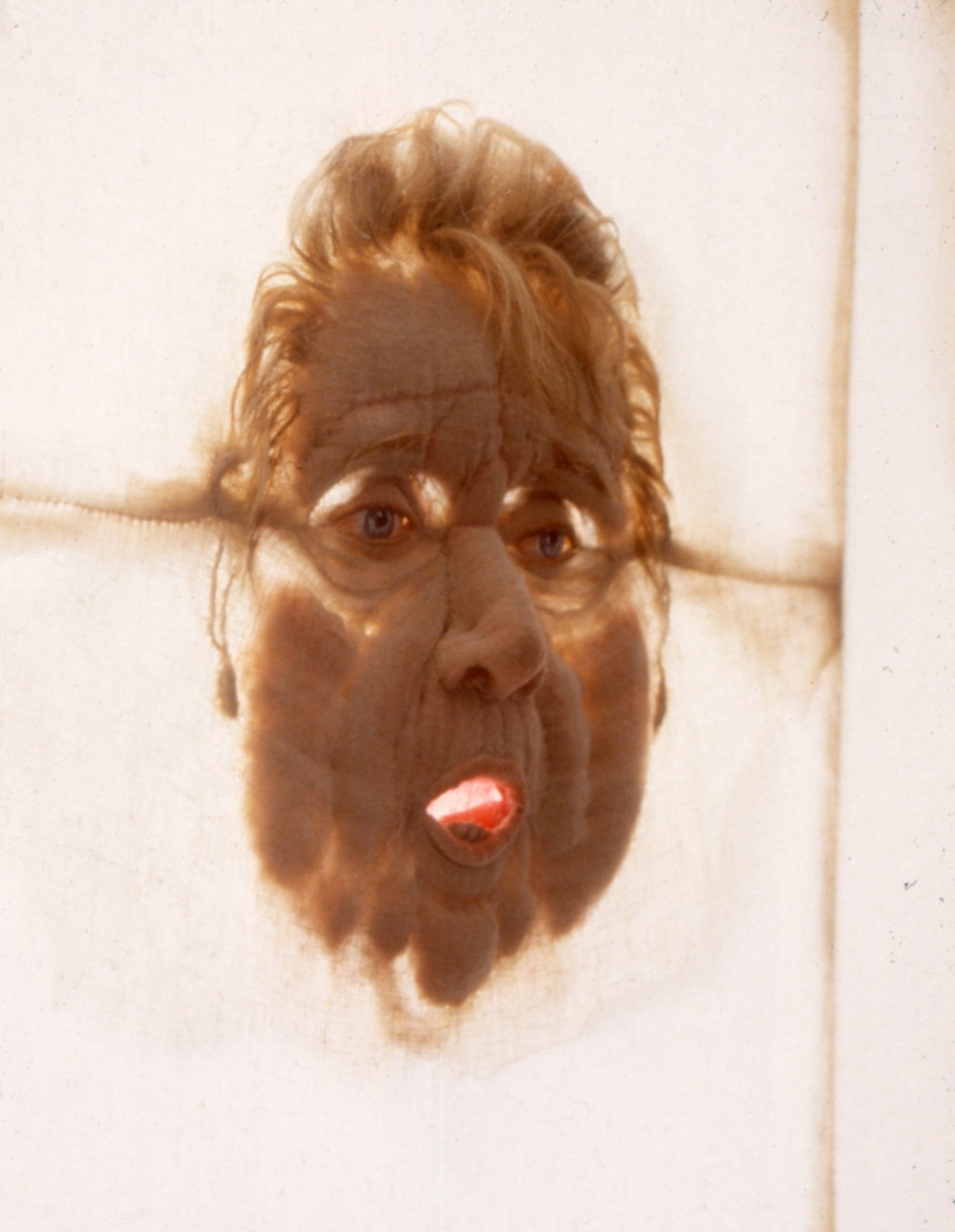
Shenstone’s cloth head portrait commissioned by Francis Bacon
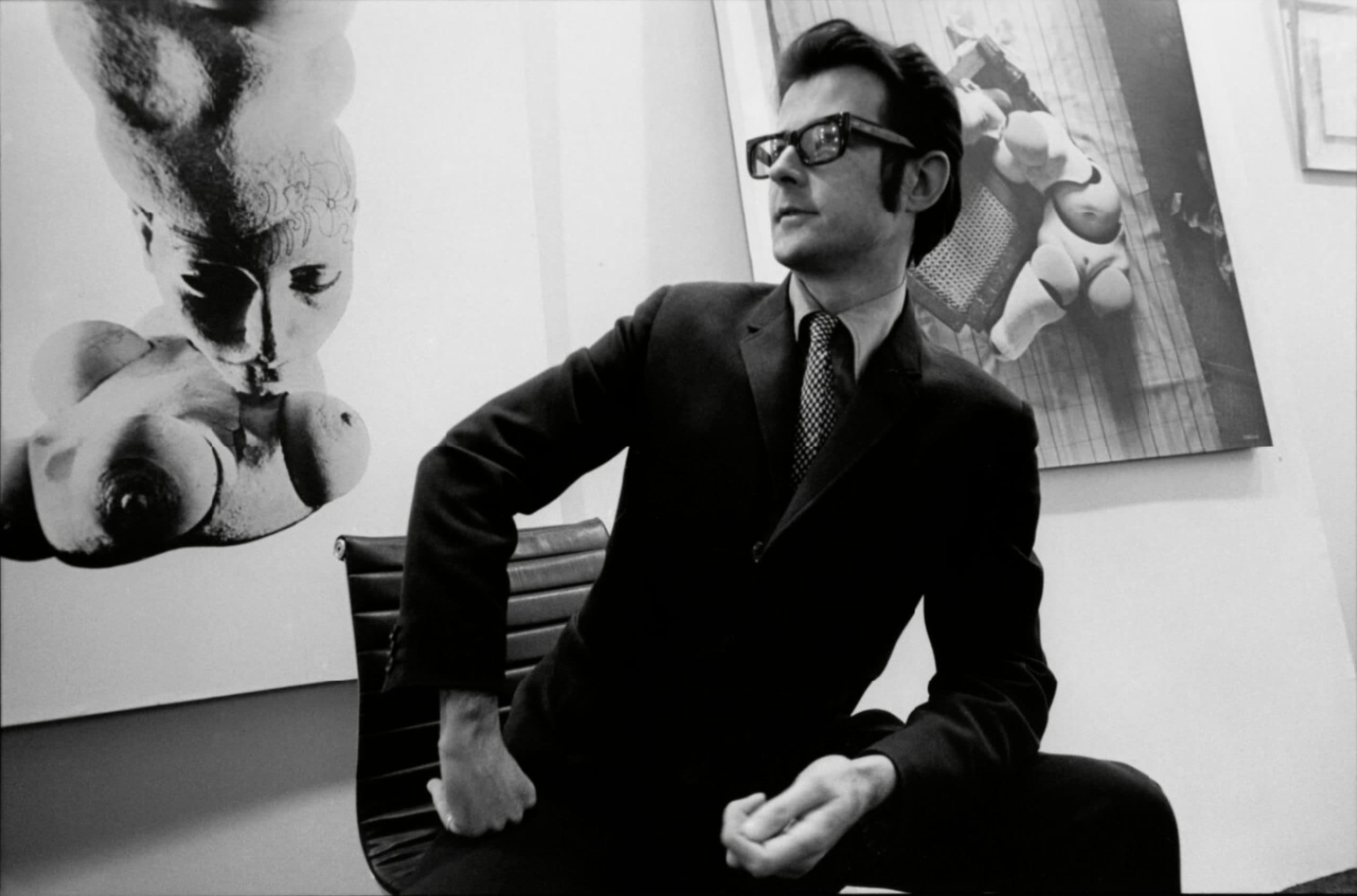
Dealer Robert Fraser photographed by Graham Keen
1985:
EXHIBITION
Robert Fraser Gallery, London.
Shenstone’s ‘Janet’ was exhibited in the window of Robert Fraser’s infamous London gallery.
1997:
ACQUISITION
National Portrait Gallery, London.
London’s National Portrait Gallery acquires one of Shenstone’s large conté drawings of Francis Bacon.

Clare Shenstone, ‘Francis Bacon’, conté on paper, 1982
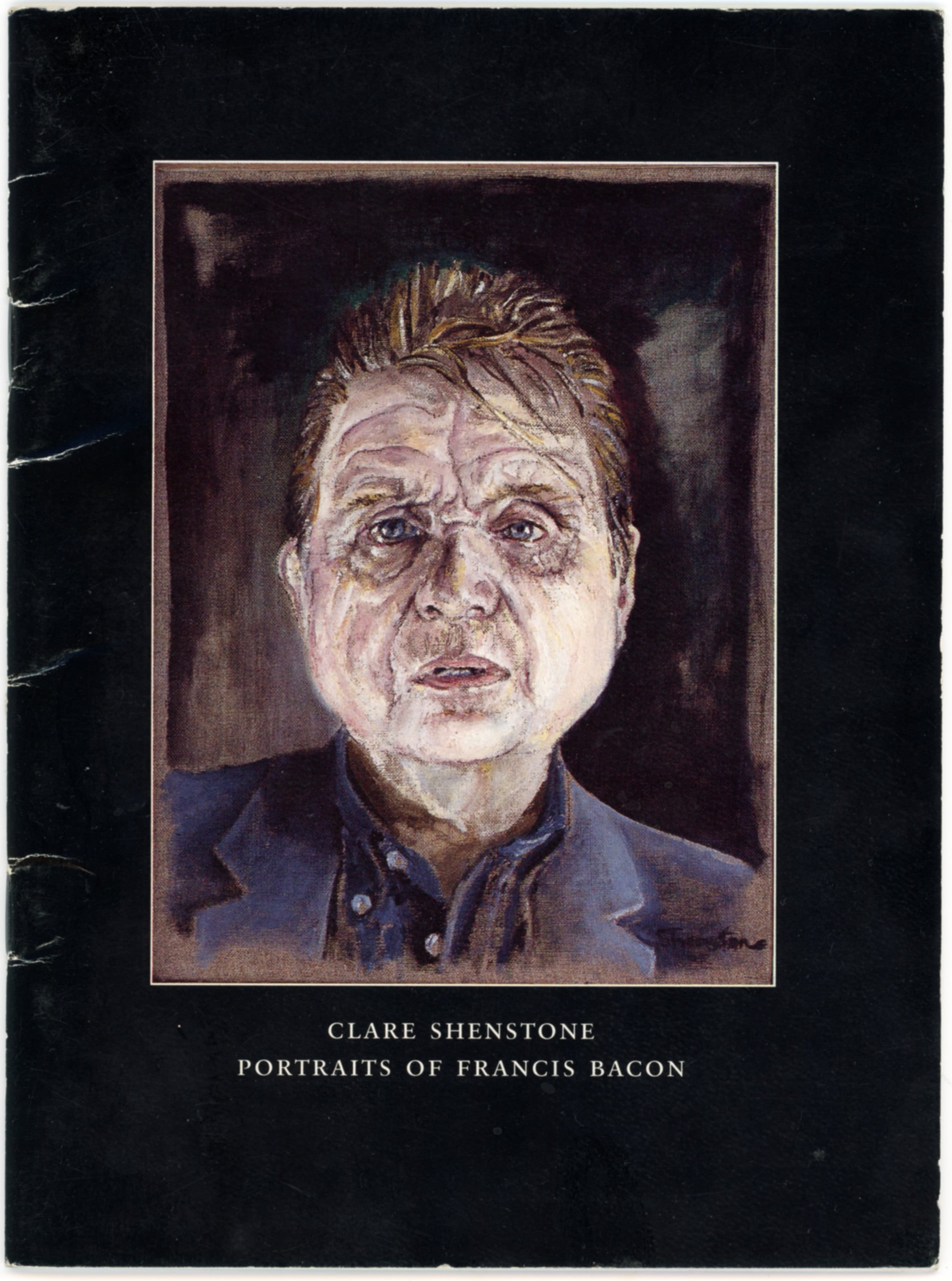
catalogue cover of ‘Portraits of Francis Bacon’
1998:
EXHIBITION
“Portraits of Francis Bacon”, Michael Parkin Gallery, London.
A solo exhibition of Shenstone’s extensive range of portraiture around Francis Bacon. It’s from this exhibition that Lord Robert and Lady Lisa Sainsbury first acquired Shenstone’s work and pursued trying to buy the original Janet cloth head.
2002:
EXHIBITION
“Personification”, Sainsbury Centre, Norwich, UK.
Lord and Lady Sainsbury became notable collectors of Shenstone’s work. Later, the iconic Norman Foster-designed gallery, which took the name of its patrons, hosted Shenstone’s largest retrospective to date. It also became the most successful and best-attended exhibition ever held there.
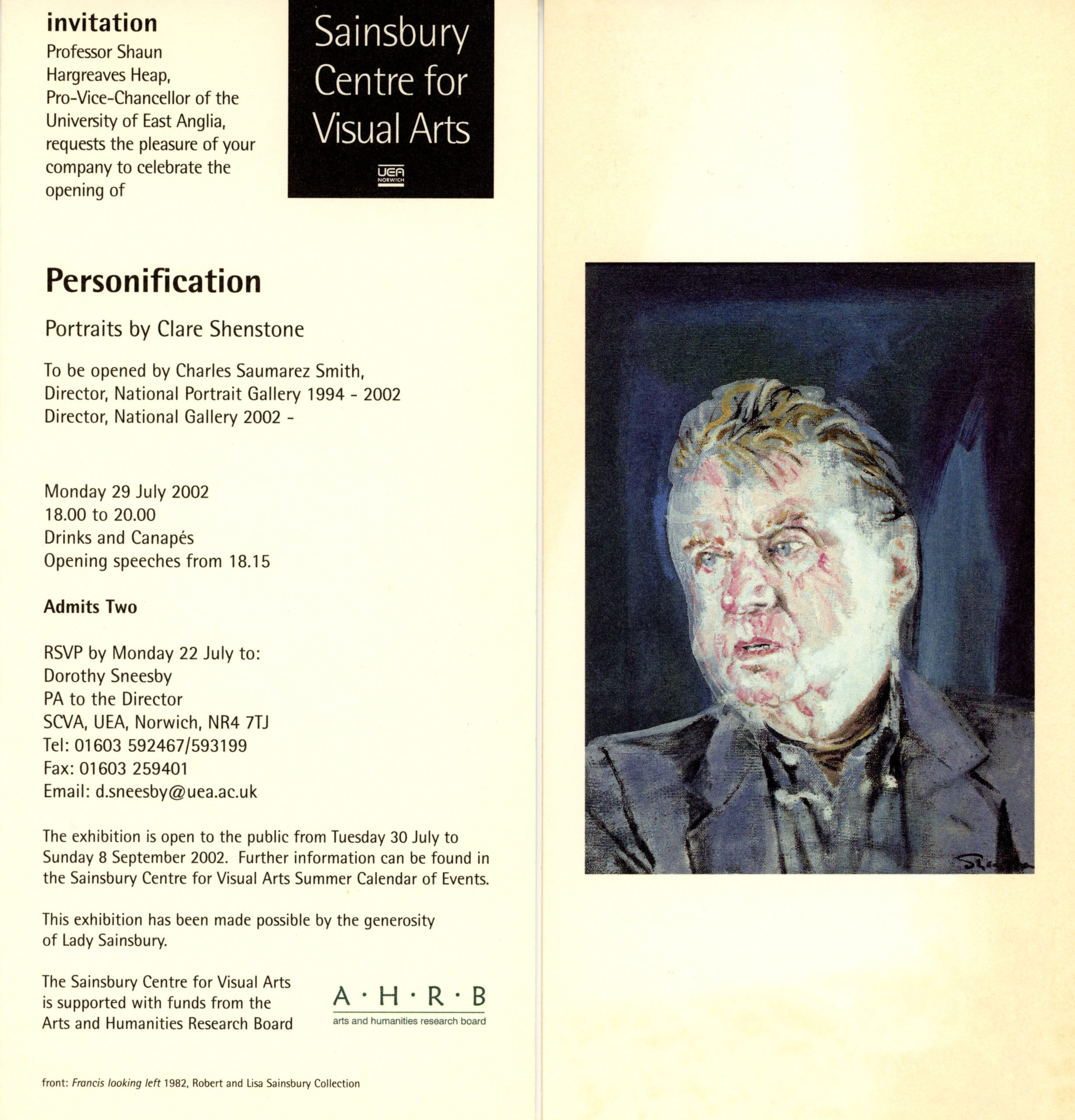
Invitation to the private view
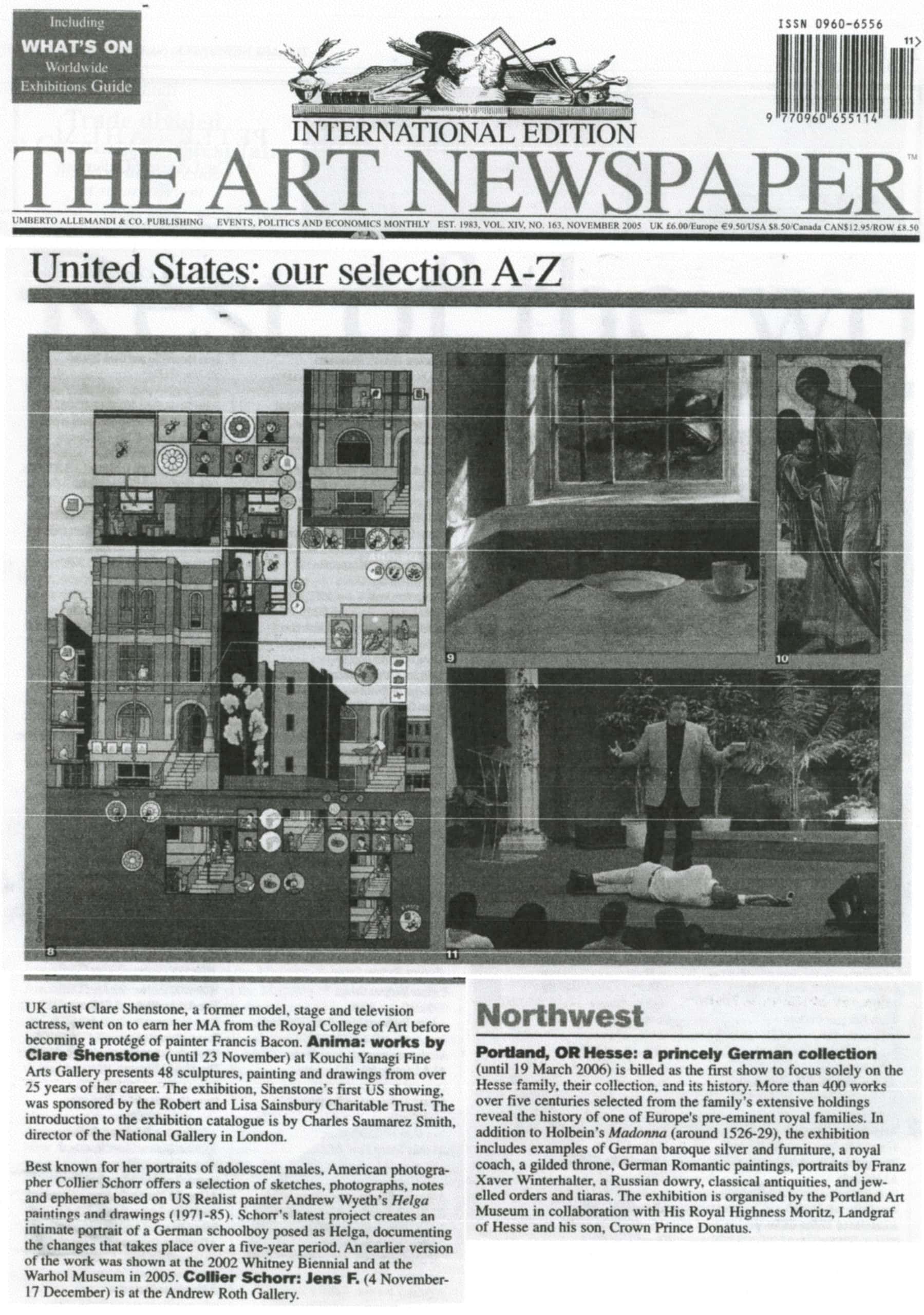
Clipping from The Art Newspaper
2005:
EXHIBITION
“Anima”, Koichi Yangi Gallery, New York.
Anima introduced to New York the range of scale and media that Shenstone brings to her study of the human form, from large drawings and paintings of famous faces to playful miniature wire sculptures.
2007:
EXHIBITION
“The Speaker and I”, Ben Brown Gallery, London.
Shenstone has been fascinated by a character who spoke at London’s ‘speaker’s corner’ since her student days and has created many paintings capturing his animated face. Equally, she has created many paintings and studies using her own face. They became the focus of a solo exhibition at Ben Brown Gallery.
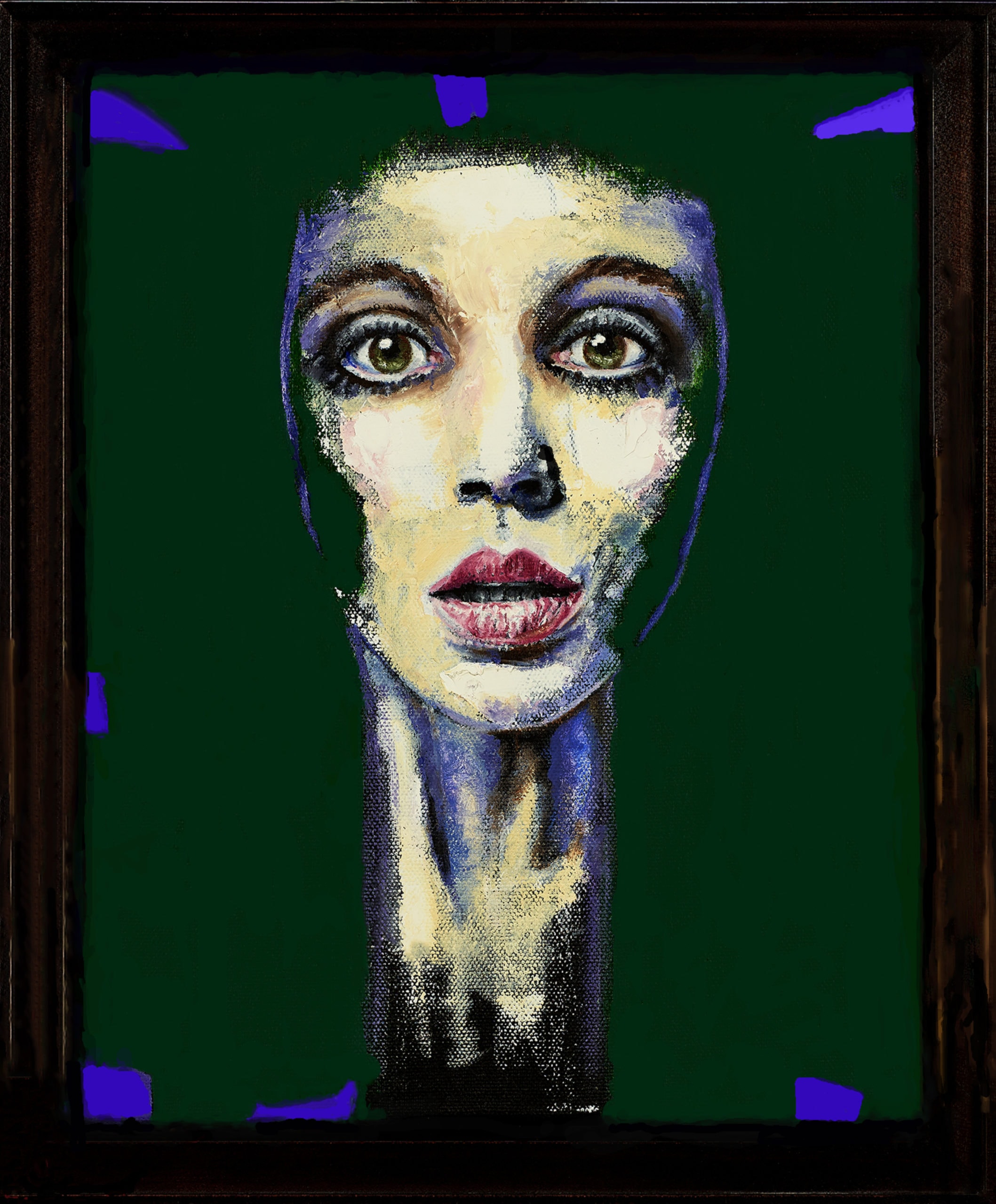
Detail of ‘Green and Purple Head’, oil on canvas, 2007

Detail of ‘The Speaker’, triptych, oil on canvas, 2007
2008:
EXHIBITION
Ben Brown Gallery, Hong Kong.
Further international exhibitions extended the reach of Shenstone’s collectors, with buyers based in the U.S., Italy, Switzerland, Hong Kong, Russia, Monaco, the Channel Islands and the Maldives.
2022:
TODAY
Shenstone continues to make work from her studio in West London. With her work in the collections of notable figures such as Harold Pinter, David Bowie and Iman, and iconic institutions such as the National Portrait Gallery, London, and the Francis Bacon Estate, interest in Shenstone’s art continues to grow internationally.
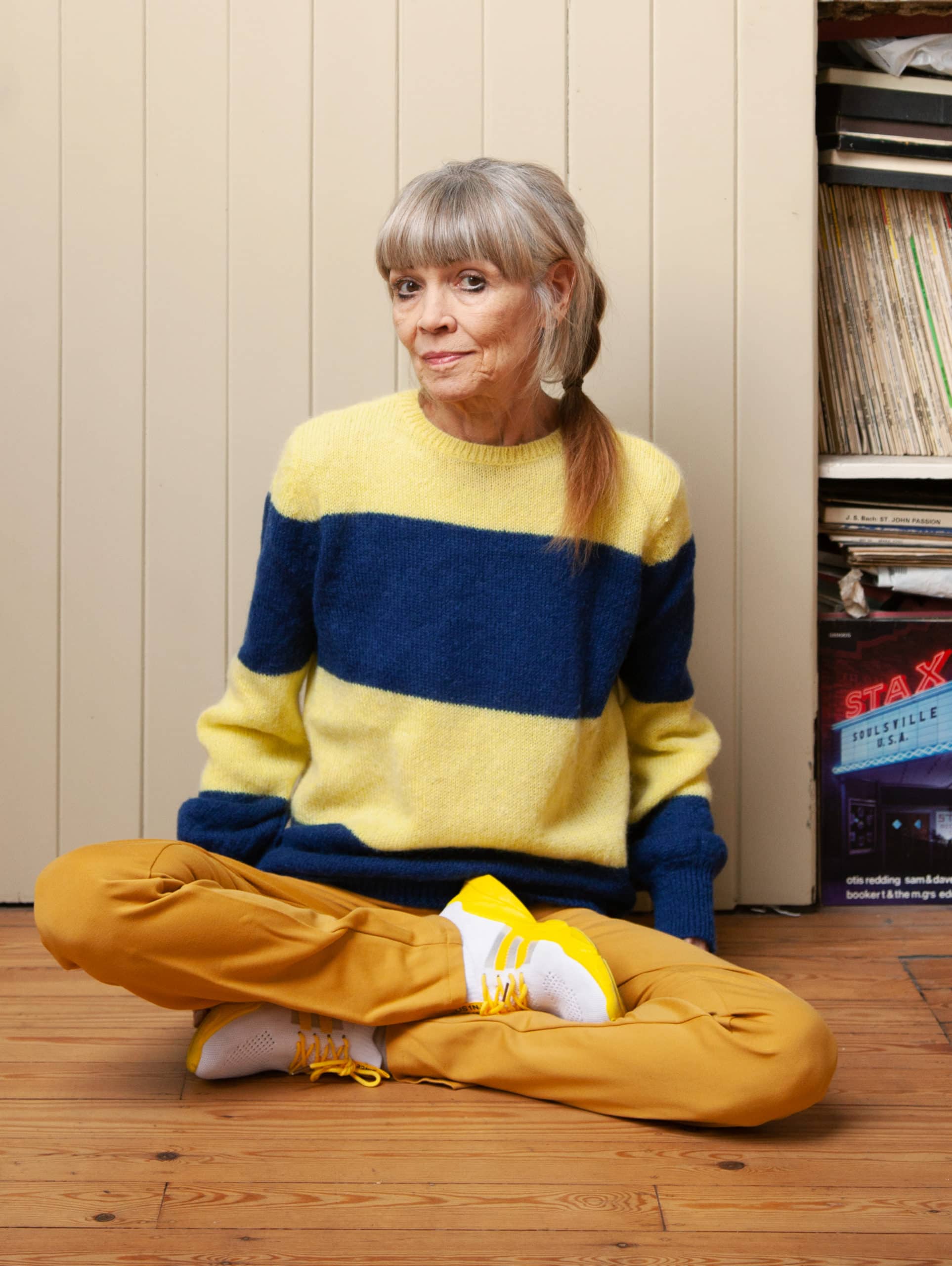
Clare Shenstone, 2022
Timeline
1966:
Chelsea Girls poster released.
Shenstone modelled for what would become one of the most iconic film posters of all time: the Alan Aldridge-designed poster for the release of Andy Warhol’s film Chelsea Girls. Warhol famously commented that he “wished the movie was as good as the poster.”

Poster for Warhol’s ‘Chelsea Girls’
1971-72:
ACTING
Shakespeare’s Hamlet.
Shenstone took on the West End run of Sir Ian McKellen’s Hamlet at the Cambridge Theatre, London, working on her art in the daytimes and performing in the evenings.


One of Shenstone’s early wall hangings
1973-6:
STUDY
BA Painting, Chelsea School of Art, London.
Shenstone’s early work was markedly different to the work she has become known for. During her BA degree she created big, abstract wall hangings based on studies of trees.

Shenstone’s first cloth head, ‘Janet’
1976-79:
STUDY
MA Painting, Royal College of Art, London.
Shenstone returned to rigorously drawing from life during her RCA days; however most notably it was here that Shenstone developed her unique ‘cloth head’ technique.

1980:
EXHIBITION
Lyric Theatre Hammersmith, London.
A solo exhibition to launch the opening of the new Lyric Theatre in Hammersmith, which featured Bacon’s loan of Janet.

Shane Connaughton
1980:
COMMISSION
Paintings for ‘Escape!’
Commissioned by the BBC to create the paintings of the central character in Shane Connaughton’s screenplay.

1981:
COMMISSION
Drawings for ‘No End of Blame’.
The Oxford Playhouse Company commissioned Clare to create six drawings for one of the two main characters and Gerald Scarfe was commissioned to create six drawings for the other. The images were projected as the backdrop to each scene. The play transferred to the Royal Court Theatre, London.
1982:
EXHIBITION
‘Artists of the Colony Room Club: a Tribute to Muriel Belcher’, Parkin Gallery, London.
Muriel Belcher was the inimitable founder of the Colony Room Club in London. Until Belcher’s death in 1979, the club hosted a who’s-who of cultural greats, including Lucien Freud, William Burroughs, Henri Cartier-Bresson. Shenstone exhibited in Parkin Gallery’s celebration of Belcher’s life.

1984:
COMMISSION
Clare completes portrait of Francis Bacon.
At the Marlborough Gallery in London, Shenstone unveils the cloth head portrait that Francis Bacon commissioned; “I can get rid of my mirror now,” he says, “I won’t be needing it anymore.”

Shenstone’s cloth head portrait commissioned by Francis Bacon
1997:
ACQUISITION
National Portrait Gallery, London.
London’s National Portrait Gallery acquires one of Shenstone’s large conté drawings of Francis Bacon.

Clare Shenstone, ‘Francis Bacon’, conté on paper, 1982
2002:
EXHIBITION
“Personification”, Sainsbury Centre, Norwich, UK.
Lord and Lady Sainsbury became notable collectors of Shenstone’s work. Later, the iconic Norman Foster-designed gallery, which took the name of its patrons, hosted Shenstone’s largest retrospective to date. It also became the most successful and best-attended exhibition ever held there.

Invitation to the private view
2007:
EXHIBITION
“The Speaker and I”, Ben Brown Gallery, London.
Shenstone has been fascinated by a character who spoke at London’s ‘speaker’s corner’ since her student days and has created many paintings capturing his animated face. Equally, she has created many paintings and studies using her own face. They became the focus of a solo exhibition at Ben Brown Gallery.

Detail of ‘Green and Purple Head’, oil on canvas, 2007

Clare Shenstone, 2022
2022:
TODAY
Shenstone continues to make work from her studio in West London. With her work in the collections of notable figures such as Harold Pinter, David Bowie and Iman, and iconic institutions such as the National Portrait Gallery, London, and the Francis Bacon Estate, interest in Shenstone’s art continues to grow internationally.

Shenstone performing in Peer Gynt
1969-70:
ACTING
Henrik Ibsen’s Peer Gynt.
Shenstone was cast as Solveig in the Oxford Playhouse Company’s production of Peer Gynt in Oxford, which then toured the UK.
1970-71:
ACTING
Joins Prospect Theatre Company.
Shenstone joins the Prospect Theatre Company playing Constantia in Man of the World and then performing in Sir Ian McKellan’s Hamlet, touring the UK and then Europe.

1972-3:
STUDY
Foundation, Central School of Art and Design, London.

The Central School of Art and Design, London

Shenstone performing in Ivanov alongside Mia Farrow
1976:
ACTING
Joins Royal Shakespeare Company.
Shenstone played alongside John Wood and Mia Farrow in the Royal Shakespeare Company’s production of Chekhov’s Ivanov at the Aldwych Theatre.

‘Janet’ hanging in Francis Bacon’s studio
1979:
ACQUISITION
Francis Bacon buys Janet.
A visitor to Shenstone’s RCA graduation show left his telephone number. It was Francis Bacon: “I adore your work”, he told me. “My gosh!” I said, “well, I think you’re the best artist alive in the world today.” He said, “Great minds think alike! I love Janet. Will you let me buy her?” I told him there’s nobody I would rather have a piece of my work.
1980:
COMMISSION
Francis Bacon Portrait.
Following the return of Janet from the Lyric Theatre, Francis Bacon rang: “I’ve been thinking, would you do my portrait? A cloth head.” “Oh God!” I replied, I don’t know whether I can.” I’d never made a formal portrait. “Will you try?” he asked, and I agreed to have go. “We’ll just see what happens,” he said, “you come around, we’ll chat about it and let’s have a sitting.”

One of many photographs of Francis Bacon by Shenstone

1981:
COMMISSION
Manhattan Theatre Club, New York.
Manhattan Theatre Club produced their own production of ‘No End of Blame’ and commissioned further work from Shenstone.

1982:
EXHIBITION
“Small Work”, Nicola Jacobs Gallery, Cork Street, London.

Whitechapel Gallery, London
1983 & 84:
EXHIBITION
Whitechapel Open Exhibition, Whitechapel Gallery, London.
Shenstone’s work was exhibited in consecutive years in the Whitechapel Gallery’s ‘Whitechapel Open Exhibition.’

Dealer Robert Fraser photographed by Graham Keen
1985:
EXHIBITION
Robert Fraser Gallery, London.
Shenstone’s ‘Janet’ was exhibited in the window of Robert Fraser’s infamous London gallery.

catalogue cover of ‘Portraits of Francis Bacon’
1998:
EXHIBITION
“Portraits of Francis Bacon”, Michael Parkin Gallery, London.
A solo exhibition of Shenstone’s extensive range of portraiture around Francis Bacon. It’s from this exhibition that Lord Robert and Lady Lisa Sainsbury first acquired Shenstone’s work and pursued trying to buy the original Janet cloth head.
2005:
EXHIBITION
“Anima”, Koichi Yangi Gallery, New York.
Anima introduced to New York the range of scale and media that Shenstone brings to her study of the human form, from large drawings and paintings of famous faces to playful miniature wire sculptures.

Clipping from The Art Newspaper
2008:
EXHIBITION
Ben Brown Gallery, Hong Kong.
Further international exhibitions extended the reach of Shenstone’s collectors, with buyers based in the U.S., Italy, Switzerland, Hong Kong, Russia, Monaco, the Channel Islands and the Maldives.

Detail of ‘The Speaker’, triptych, oil on canvas, 2007
Privacy Overview
| Cookie | Duration | Description |
|---|---|---|
| cookielawinfo-checkbox-analytics | 11 months | This cookie is set by GDPR Cookie Consent plugin. The cookie is used to store the user consent for the cookies in the category "Analytics". |
| cookielawinfo-checkbox-functional | 11 months | The cookie is set by GDPR cookie consent to record the user consent for the cookies in the category "Functional". |
| cookielawinfo-checkbox-necessary | 11 months | This cookie is set by GDPR Cookie Consent plugin. The cookies is used to store the user consent for the cookies in the category "Necessary". |
| cookielawinfo-checkbox-others | 11 months | This cookie is set by GDPR Cookie Consent plugin. The cookie is used to store the user consent for the cookies in the category "Other. |
| cookielawinfo-checkbox-performance | 11 months | This cookie is set by GDPR Cookie Consent plugin. The cookie is used to store the user consent for the cookies in the category "Performance". |
| viewed_cookie_policy | 11 months | The cookie is set by the GDPR Cookie Consent plugin and is used to store whether or not user has consented to the use of cookies. It does not store any personal data. |
